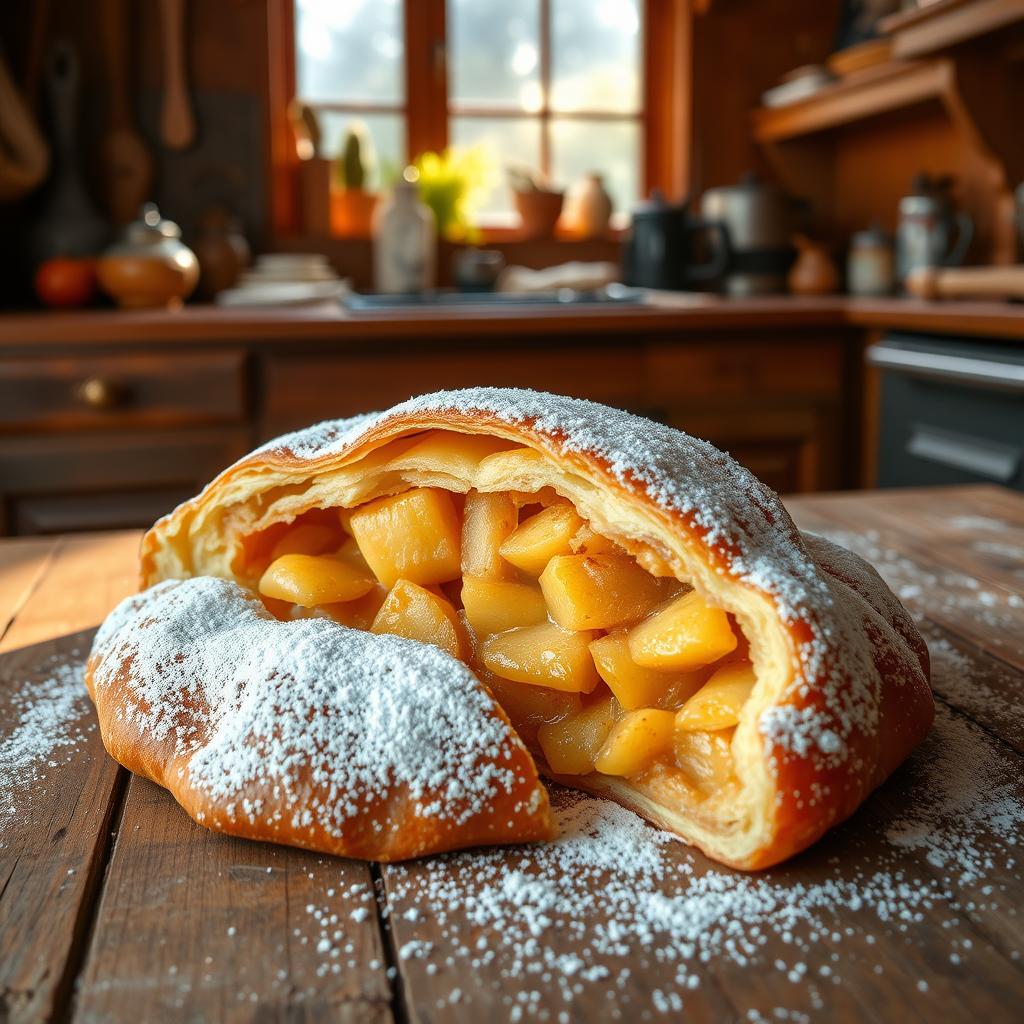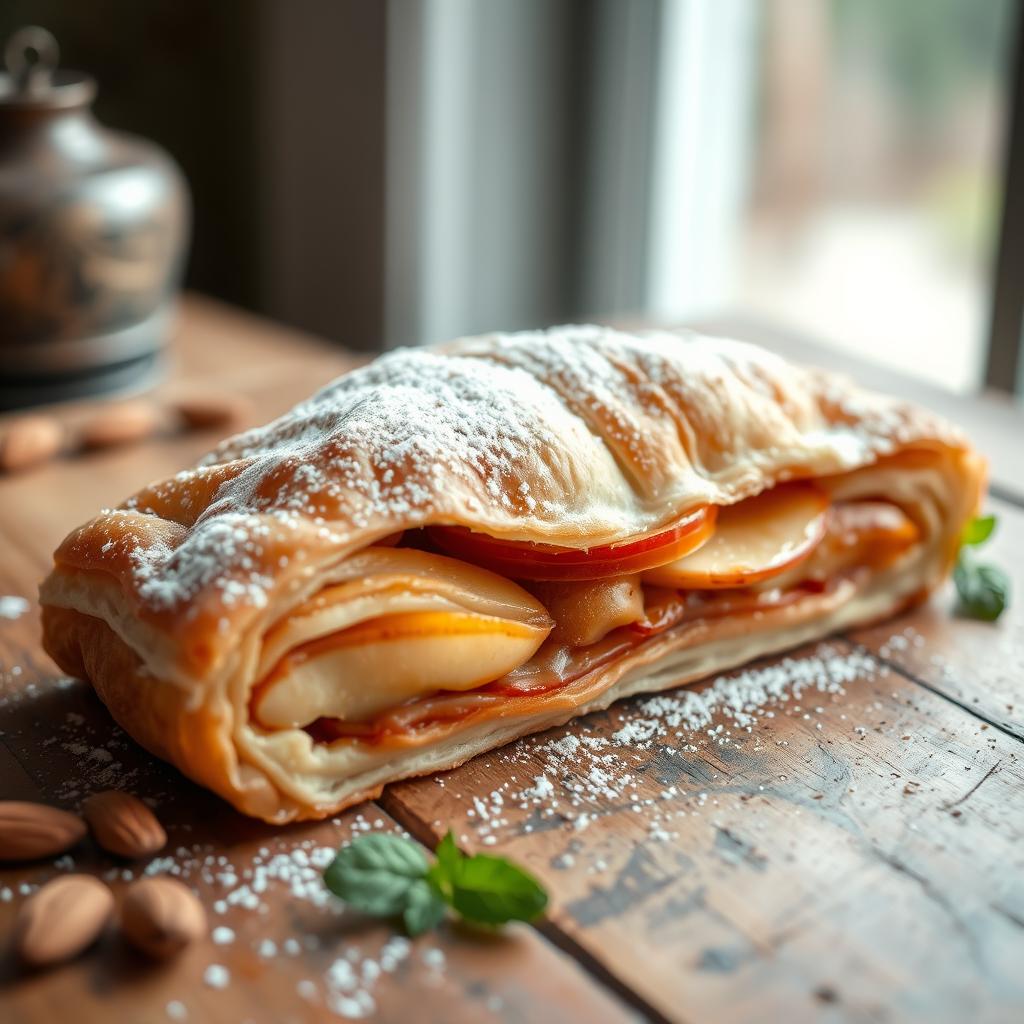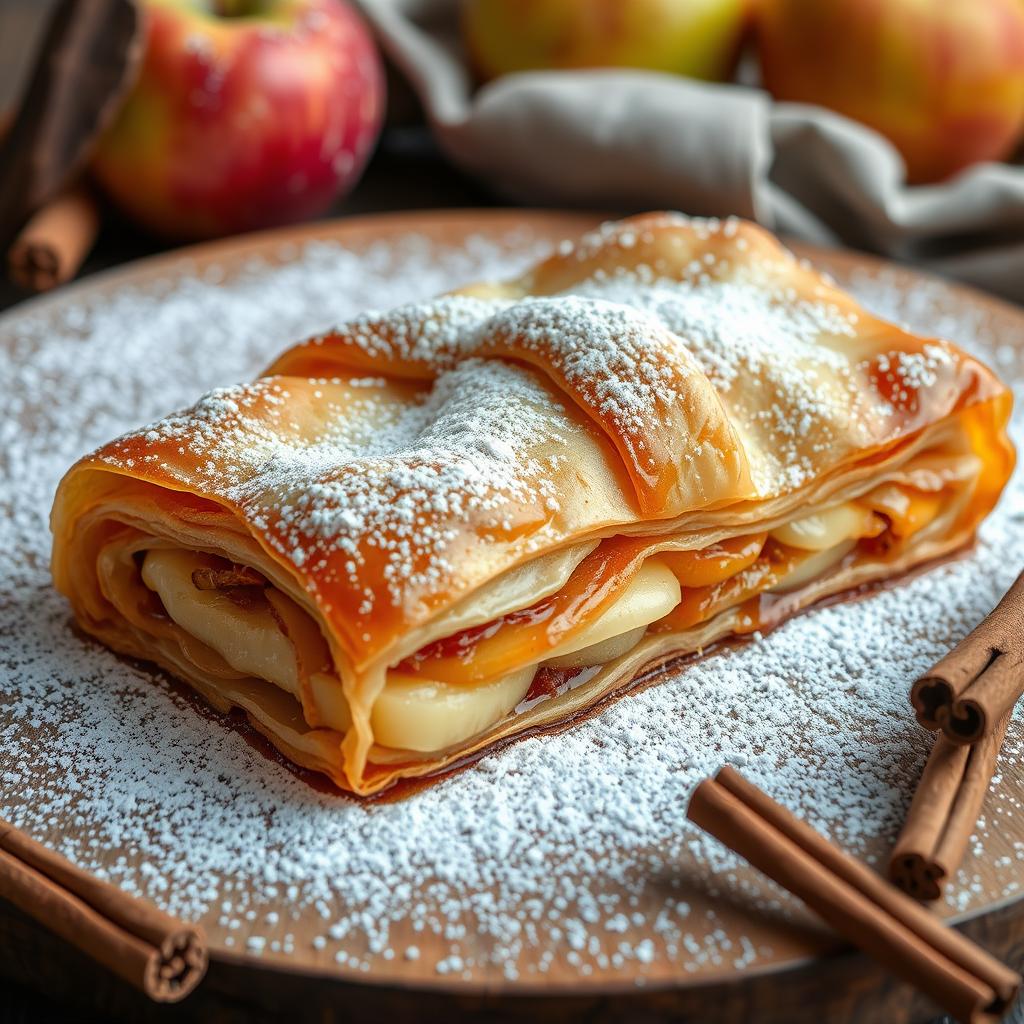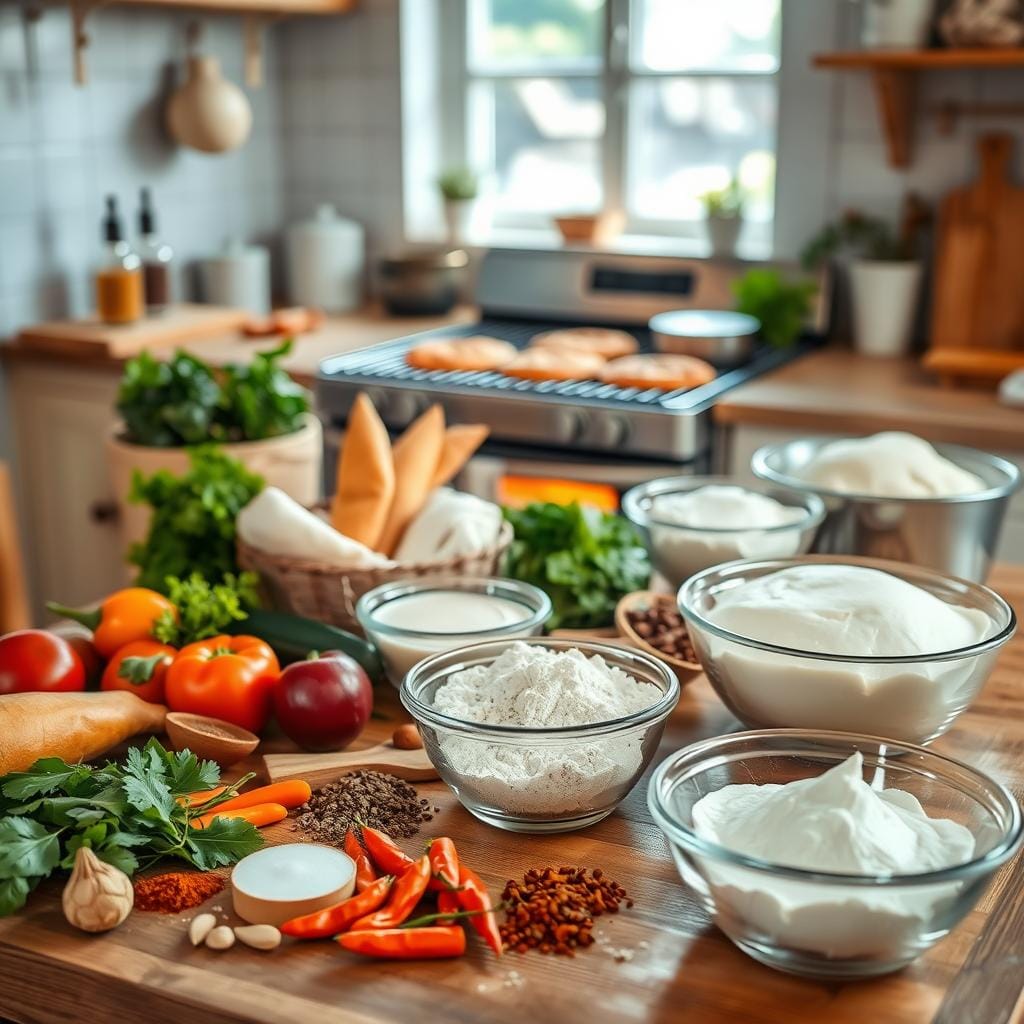What does the German word strudel mean? When you take a bite of strudel, it brings a wave of comfort and nostalgia. This beloved pastry, hailing from Germany and Austria, has captured hearts and taste buds worldwide. But have you ever wondered about its meaning? Let’s explore its history and cultural significance.
Strudel is a symbol of Germanic cuisine, loved for its name and look. Its history is rich and spans centuries, crossing cultures. The story of strudel shows how food can unite people and create lasting memories.

Key Takeaways
- Strudel is a beloved pastry that originated in the German and Austrian culinary traditions.
- The word “strudel” has a rich history and linguistic evolution, tracing back to the Middle High German language.
- Strudel holds deep cultural significance in German-speaking regions, often associated with traditional family gatherings and festive celebrations.
- Understanding the basic components and preparation methods of strudel is crucial to appreciating its artistry and versatility.
- Strudel has influenced global pastry making, with various international adaptations and contemporary interpretations.
pastry can take us back in time, bringing up memories and feelings that go beyond words and cultures. As we explore strudel’s story, we’ll see its origins, cultural value, and lasting impact on food arts.
The Etymology and Origin of the Word Strudel
The German word “strudel” comes from Middle High German. It’s a traditional baked good loved in German-speaking areas. The name has changed over time, just like the dish.
Historical Language Development
The word “strudel” started in Middle High German. It meant a swirling or whirlpool-like movement. This fits the German strudel pastry perfectly, with its dough and fillings.
Middle High German Connections
The word “strüttel” came before “strudel.” It meant twisted or coiled. This matches the strudel recipe design.
Linguistic Evolution Through Centuries
- The word “strudel” got more precise over time. It became what we know today.
- By the 16th century, “strudel” was a key term in German. It meant the spiral-shaped baked good.
- Now, “strudel” is a key part of German and Austrian food culture. It’s loved by many for its delicious taste.

The word “strudel” shows the deep culture and lasting love for this German baked good. Its history shows how this pastry has stayed popular over time.
What Does the German Word Strudel Mean?
Ever wondered about the German word “strudel”? You’re in the right spot. The word “strudel” comes from German, meaning “whirlpool” or “eddy.” It’s fitting, as the pastry is known for its flaky dough that swirls into a beautiful shape.
The strudel’s look, with its thin layers of dough and tasty filling, reminds us of a whirlpool. This connection has made the term “strudel” famous worldwide, not just in Germany.
“The word ‘strudel’ evokes images of a delicate, spiraling pastry that is as much a delight to the eyes as it is to the taste buds.”
So, when you have a slice of this iconic flaky dough treat, think about its name. It’s a nod to its unique and eye-catching form, loved by pastry fans for ages.

The Cultural Significance of Strudel in German-Speaking Regions
In German and Austrian cuisine, strudel is a symbol of shared heritage and tradition. It’s more than just a dessert; it’s a cherished part of family gatherings and festive celebrations.
Traditional Family Gatherings
Strudel is a big part of German and Austrian family life. It brings people together on special occasions like birthdays and holidays. The tradition of baking strudel and sharing recipes shows its lasting cultural value.
Festive Celebrations
Strudel is a key part of many German and Austrian festivities. It fills Christmas markets with its aroma and is a highlight at weddings. Each region has its own twist, making it a symbol of joy and indulgence.
Regional Variations
- In Bavaria, you may find the classic apple strudel, often served with a dusting of powdered sugar and a dollop of whipped cream.
- Viennese strudel, on the other hand, is renowned for its delicate, paper-thin dough and a range of fillings, from poppy seed to cheese.
- Across the Alps in the Tyrol region, the strudel may feature a heartier, more rustic filling, such as spiced pumpkin or savory spinach and feta.
These regional variations show the culinary creativity of the German-speaking world. They also reflect the cultural traditions that have shaped strudel over time.
Strudel’s lasting impact in German and Austrian regions shows its power to unite people. It preserves traditions and celebrates the diversity of these culinary landscapes. Whether enjoyed at family gatherings or grand celebrations, strudel remains a beloved treat.
Understanding the Basic Components of Strudel Pastry
The charm of a well-made strudel comes from its balance of key parts. At its core is the flaky dough, the base of this German favorite. It’s paired with fruit fillings and nut fillings that have won hearts for ages.
The flaky dough is the heart of a real strudel. It’s made by stretching and layering the dough to get its light, airy feel. This process is an art, needing skill and patience for the right texture.
Strudels are filled with a mix of fruit or nuts. Favorites like apple, cherry, and poppy seed add unique tastes to the dough. For nut lovers, there are fillings with walnuts, almonds, or hazelnuts.
The mix of flaky dough and fruit or nut fillings makes the strudel special. Each bite is a mix of textures and tastes, making it unforgettable.
The Art of Making Traditional Strudel Dough
Making the perfect traditional recipe for baked good strudel dough is a delicate art. It requires a mix of skill and patience. The key is to stretch the dough to a thin sheet, just like paper.
Dough Stretching Techniques
To get the dough to a thin, tissue-like texture, you need the right technique. Bakers use their hands to gently stretch the dough. They pull and stretch it until it’s almost see-through. This step needs a soft touch and careful eyes to avoid any tears.
Essential Tools and Equipment
- Large, clean work surface
- Rolling pin or dough roller
- Pastry cloth or linen towel
- Sharp knife or pizza cutter
Common Mistakes to Avoid
- Overworking the dough, making it tough
- Letting the dough dry out while stretching
- Using too much flour, making the dough hard
- Rushing the stretching, causing unevenness and tears
Learning to make traditional strudel dough takes time and effort. But the results are worth it. With patience and the right techniques, you can make a flaky baked good. It will impress your taste buds and take you back to German-speaking culinary traditions.
Popular Strudel Varieties and Fillings
Strudel is a beloved German and Austrian pastry with endless possibilities. It comes in many delicious varieties, each with its own taste. From the classic fruit filling to the rich nut filling, it’s a true dessert treat.
The classic apple strudel is a favorite. It has a flaky, buttery dough filled with tart apples, cinnamon, and sugar. Other fruit fillings like cherry strudel and blueberry strudel are also loved.
- Apple strudel
- Cherry strudel
- Blueberry strudel
For those who love nut fillings, there’s walnut strudel and poppy seed strudel. These fillings are rich and nutty, perfect with the flaky pastry. Some places even offer savory strudels, like spinach and feta strudel or mushroom strudel.
| Strudel Variety | Filling |
|---|---|
| Apple Strudel | Apples, cinnamon, sugar |
| Cherry Strudel | Cherries, sugar |
| Walnut Strudel | Walnuts, sugar, cinnamon |
| Spinach and Feta Strudel | Spinach, feta cheese |
Strudel is a beloved dessert in German and Austrian cuisine. With so many delicious options, it’s easy to see why. Whether you like a classic fruit filling or a rich nut filling, there’s a strudel for everyone.
The Difference Between German and Austrian Strudel
German and Austrian cuisines both have a rich pastry tradition. But, they have different ways of making strudel. These differences show the diversity of German-speaking world’s cuisine. They also highlight the cultural influences on this famous dessert.
Regional Preparation Methods
In Germany, strudel dough is rolled out and layered. This makes it flaky and uniform. The fillings are simple, so the pastry can be the star.
Austrian strudel, however, has very thin dough. It’s stretched and draped over the filling. This makes the strudel look dramatic and airy.
Ingredient Variations
- German strudel often has classic fruit fillings like apple or cherry. Austrian strudels, though, have a wider variety of fillings. They might include savory options like spinach and cheese.
- Spices and flavorings also differ. German strudel uses cinnamon and vanilla. Austrian recipes might add nutmeg, cloves, or even rum or brandy.
| Characteristic | German Strudel | Austrian Strudel |
|---|---|---|
| Dough Preparation | Rolled and layered | Tissue-thin, stretched and draped |
| Fillings | Restrained, classic fruit-based | Diverse, including savory options |
| Flavorings | Cinnamon, vanilla | Nutmeg, cloves, rum or brandy |
The differences between German and Austrian strudel show their unique culinary identities. These differences reflect the regional pride and traditions that have shaped these beloved pastries over centuries.
Modern Interpretations of Classic Strudel
As the world of pastry evolves, dessert chefs are adding their own twists to strudel. They’re mixing up flavors and presentation, making strudel exciting again. This is winning over fans of pastry all over the world.
Now, strudel comes with savory fillings and non-traditional fruits. Chefs are trying new things, like roasted vegetables or tropical fruits. It’s a fun surprise for those who love trying new things.
Also, how strudel looks is getting a makeover. You’ll find mini-strudels and layered strudel cakes. These new looks are as exciting as the tastes.
| Traditional Strudel | Modern Interpretations |
|---|---|
| Classic apple filling | Savory fillings, such as roasted vegetables |
| Rectangular or oval shape | Individualized mini-strudels, layered strudel cakes |
| Served as a slice | Presented as a whole, visually stunning dessert |
These new takes on strudel keep its heritage alive while bringing it into the future. They show how creative pastry can be.
“The beauty of strudel lies in its ability to evolve while still respecting its timeless roots. These modern interpretations showcase the incredible versatility of this beloved dessert.”
How Strudel Influenced Global Pastry Making
The German cuisine and Austrian cuisine are famous for their delicious pastries. Strudel, a flaky, fruit-filled pastry, has won hearts globally. It has also inspired many to try new pastry traditions.
International Adaptations
Strudel’s popularity grew, and bakers worldwide started to play with the recipe. In places like the United States and Asia, chefs used the strudel’s dough and fillings to create their own versions. These new creations celebrate local tastes and traditions.
- In the United States, strudel got a makeover with apple, cherry, and even savory fillings like spinach and feta.
- Japanese bakers mixed matcha with traditional fruit fillings in their strudel.
- Indian chefs made strudel-like pastries with spiced lentils, vegetables, and spices.
Contemporary Culinary Impact
The strudel has had a big impact on global cooking, thanks to German cuisine and Austrian cuisine. Today, chefs are using strudel techniques and flavors in new desserts. This has led to unique and exciting desserts.
| Strudel-Inspired Desserts | Description |
|---|---|
| Strudel Cheesecake | A rich, creamy cheesecake with a layer of strudel-style fruit filling and a crisp, flaky crust. |
| Strudel-Wrapped Ice Cream | Scoops of ice cream wrapped in a thin layer of strudel dough, baked to golden perfection. |
| Strudel-Inspired Tarts | Bite-sized tarts featuring a strudel-like pastry crust and a variety of sweet or savory fillings. |
The strudel’s lasting impact continues to inspire chefs globally. It shows how this beloved pastry can bring cultures together and change dessert-making.
Tips for Perfect Strudel Preparation at Home
Making a traditional strudel at home might seem hard, but with some tips, you can get it right. The key is to make flaky dough and pick the right filling. This will make your strudel taste like it’s from a bakery.
Start by kneading and stretching the dough until it’s very thin. This step is crucial for a light and crispy texture. Use a strong rolling pin and a smooth surface to help stretch the dough.
For the filling, choose a classic mix of apples, cinnamon, and raisins. Or, try something different like sweet cheese or spinach. Make sure the filling isn’t too wet. This will help keep the strudel crispy. Roll and assemble the strudel carefully to avoid air pockets. This ensures it bakes evenly and tastes great.
FAQ
What does the German word “strudel” mean?
“Strudel” is a German pastry known for its flaky dough and fillings like fruit or nuts. It comes from “Strudelein,” meaning “little whirlpool.” This name fits the pastry’s layered, swirling pattern.
What are the basic components of strudel pastry?
Strudel pastry has a thin, flaky dough and a sweet or savory filling. The dough is made from flour, eggs, and water. It’s stretched or rolled out to create thin layers. Fillings can be apples, cherries, nuts, or even cheese or spinach.
How does strudel differ between German and Austrian cuisine?
German and Austrian strudels have some differences. German strudel has a richer, buttery dough and more fillings. Austrian strudel has a thinner dough and often uses fruit like apples or cherries.
What is the cultural significance of strudel in German-speaking regions?
Strudel is very important in German and Austrian culture. It’s enjoyed at family gatherings and festive events. It’s a beloved dessert or snack, passed down through generations.
How has strudel influenced global pastry-making?
Strudel has inspired bakers worldwide to create their own versions. It’s seen in pastries with local fruits and flavors. Even modern desserts blend strudel with other traditions, showing its global impact.



Pingback: What is the meaning of quesillo? - Mexican Cheese Guide